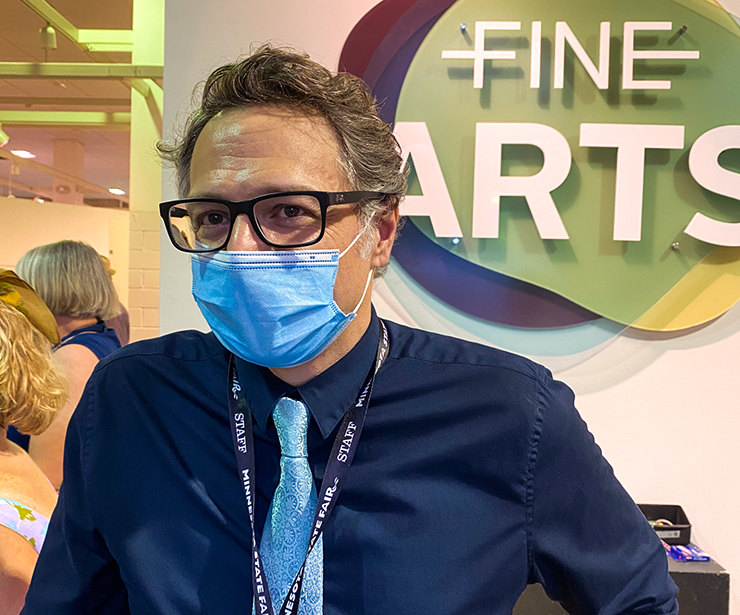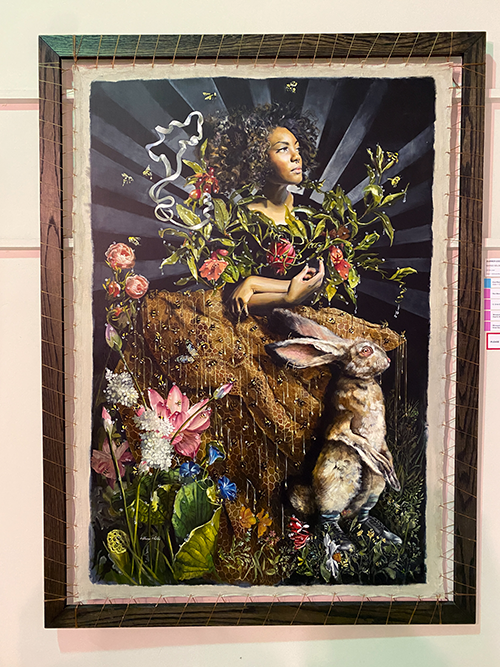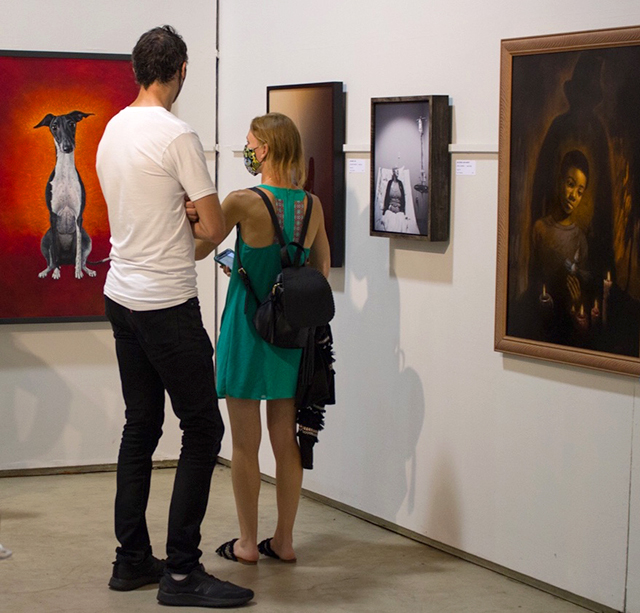Amid the noise, smells and crowds of the Minnesota State Fair, the Fine Arts Exhibition is a world of its own. Step inside the red brick building on the corner of Randall and Cosgrove and things slow down – your feet, your breathing, maybe even your heart rate. You’re not there to eat, drink, ride, scream, rock out, pat a cow or win the biggest prize on the Midway. You’re there to look at art.
How much art? For 2021, 321 items. Breaking it down: 110 photographs, 98 oil/acrylic/mixed media works, 29 drawings/pastels, 23 watercolors, 19 sculptures, 15 works in textile/fiber, 14 in ceramics/glass and 13 prints, chosen by eight jurors from 2,462 works submitted by Minnesotans from all over the state.
That’s several hundred more than the 1,718 submitted in 2020, the first year of the pandemic. According to Jim Clark, it’s in line with the six-year average before COVID.
In 2020, the fair was canceled but the Fine Arts Exhibition was open to visitors with timed tickets. “We had some things in place already that made that feasible,” Clark said, “and then we made the other stuff up as we went.” A catalog and a virtual tour were offered online.
Jim Clark is the man in charge. The fair’s fine arts superintendent since 2011 – before then, he lived in Alaska for several years, and before then, he was a staffer for the Fine Arts Exhibition – Clark does it all, from hiring the jurors to hanging the show. His full-time job is chief visual arts administrator at the Hopkins Center for the Arts, where he also teaches drawing. He’s a practicing artist who recently completed a commission for Betty Danger’s rebranding. In short, he says, “I work every day.”
He made time for an in-person interview at the Fine Arts Building last week, during which we learned a lot about our favorite part of the fair.
On the way things used to be
Jim Clark: For 100 years, each and every work in competition was hand-delivered. The last year we did that was my first year as superintendent, 2011. We handled physically more than 2,000 works.
That wasn’t great for many reasons. The jurors came in for a single day. The jurors in the larger classes, like painting and photography, were looking at 800 pieces of art in a single day. For the artists, including the artists of Greater Minnesota, there was an 85% chance historically that you would have to come back the very next weekend to pick up your work.
If you get into the second round, it’s a greater than 50% chance, typically, that you’ll be in the show.
MinnPost photo by John Whiting The fair’s fine arts superintendent since 2011, Jim Clark does it all, from hiring the jurors to hanging the show.
What we did [in 2012] was institute a digital first round. Jurors had five days. They could log in, see their class or category, rate them, rerate them, sort them by rating, look at them for a day, get away from them for a day and come back.
But the best way to experience any art is in life, let alone to evaluate it, so we retained the live jury day. The jurors select twice as many pieces as can fit [in the show] to bring in so they can see them in life. From those, the works on display are chosen.
For the last two years, due to COVID, we’ve gone with 100% digital for acceptance but retained the in-life for awards. A lot of artists like the convenience of that.
On who can enter the show
JC: You simply need to be a Minnesota resident. That includes students, too. Some of the programs here at the fair pull entrants from Wisconsin and Iowa. We don’t do that.
We don’t charge an entry fee, and that’s unusual. Most opportunities in this field, you pay to participate. There are fewer boundaries to participate in this show than just about any other that I can think of.
On how jurors are chosen
JC: I consider their experience, their body of work, their education, and that they’re practicing artists in that field. Sometimes it’ll be someone that’s been at their work for 40 years, they never got an MFA or even a BFA, but they have a rich experience. Other times it’s someone that’s a bit younger, but they may have their terminal degree in their field, or they teach. People that teach tend to have a good, wide spectrum of understanding.
On diversity, equity and inclusion
JC: We change [jurors] every year. We try to gather people from all different types of backgrounds so the jury group is reflective of the rich tapestry that is Minnesota artists.
We don’t collect information from entrants on their background, ethnicity, race – any of that. I’ve considered we might do that, at least by election, so we might have a better understanding of the constituents that are participating. I truly believe in recognizing the individual the way they’d like to be recognized. We are all navigating that.
“Studio: HERE” is a special exhibition we didn’t have last year, but this will be the ninth year where we’ve invited 12 different Minnesota artists to come in, one for each day of the fair. They use a portion of our gallery as their working studio space. It’s an opportunity to show the public the nuts and bolts of art-making, that art-making doesn’t always look like one assumes art-making looks. People of color are part of that program as well.
[NOTE: Former MinnPost writer Andy Sturdevant (The Stroll) will be the featured artist on Thursday, Sept. 2.]
On who comes to the show
JC: We get everybody through this building. Dedicated gallery goers, art-savvy people, art-sensitive people. We also get a ton of people [for whom] this is their one and only experience with art in a year, and we don’t take that responsibility lightly.
MinnPost photo by John Whiting “Summer Goddess,” St. Paul based artist Margo Selski, Oil on Linen. First Place in Oil/Acrylic/Mixed Media, winner of the Minnesota State Fair Foundation Paul S. Kramer Award, the Minnesota Citizens for the Arts Great State of Minnesota Award and others.
On the layout of the show
JC: I believe it was Bob Lesch who came up with the floor plan. He was the superintendent when fine arts moved from the grandstand to here in 1980. It hasn’t changed much since then, and there’s a reason for that: It works. And it seems different every year.
People come in and they’re like, “Oh, it seems so much more open!” or “The walls have changed!” but they haven’t. The walls could change; they are modular. A lot of people would like it to be just straight rows. But it’s a dynamic experience, and your vistas change.
I know that 90% of the world comes through that door and goes around in counterclockwise fashion, but it’s not designed to be linear. Really, it’s circular.
On the chances of a virtual tour this year (people on Facebook are asking about that)
JC: The catalog will be online, but not the tour. The fair puts an incredible amount of resources into this show. We want people to see it because seeing art in life is the best way to experience it. We want people to buy a ticket [to the fair] and come see it. That supports the fair and keeps us going.
[This show pays artists] $10,000 in awards and prizes. It pays tens of thousands of dollars to staff. The jurors are paid. I have a few volunteers who do it just for the fun of it.
This is only the second year the catalog will be online. I can’t say that it will be in perpetuity. A big part of the thinking was the handling of cash [during the pandemic]. We normally sell the catalog for two bucks, and we’re lucky to break even.
On hanging the show
JC: It’s the best part of the gig because it’s a creative act. So yeah, I enjoy it.
As I mentioned, we get everyone through this building, and a lot of times people wonder why the award winners aren’t all in one spot, or why the show isn’t organized by subject matter or medium. Why aren’t all the pictures of fish together? Because a typical viewer is going to look for the best image of a fish. Every work in here we feel is deserving of attention.
MinnPost photo by John Whiting
Our goal is to curate a viewing experience that helps maintain energy level. It’s really easy to get into the zombie walk at the fair. You’re full of corndogs and whatnot, it’s hot, and you get the zombie shuffle going. So I look for variety and visual sympathies and affinities. So there needs to be some change, but it can’t be so abrupt as to be jarring.
I think of each wall as a visual sentence. If you have all four-letter words, that’s going to be a pretty boring thing to read, right? We like to change the sizes [of the art] because you’re suddenly coaxing an up-and-down movement to the eyes instead of just along the line, so people are really looking.
The big thing nowadays is interactivity. Everything’s got to be interactive. I’m aiming for an active viewing experience. It shouldn’t be a dirty word to look and look hard, and that’s what we’re trying to do.
And then there are the existing conditions. These are the puzzle pieces. Now we have to make them fit together. And in every year, because I engage with [the show] every day for a lot of hours, I always see something and think, ‘Oh, I wish I would have made that move!” Even on the last day, I’ll be like, “This would have been good!”
In a nutshell: Visual sympathies or affinities. Contrasts to coax or nurture as active a viewing experience as possible, and to ensure that each work gets its full due. Every year, there are works the jurors choose and I’m, like, really? But it’s my job to make each and every work sing, speak and present as well as it possibly can.
